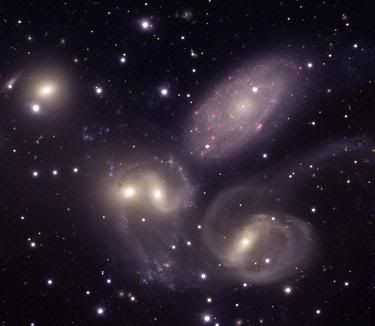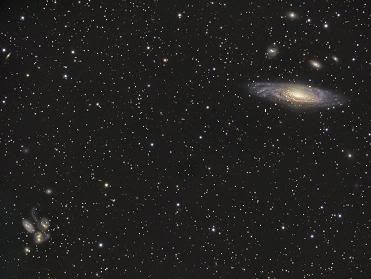Post by glactus on Jun 8, 2011 3:47:56 GMT

Stephan's Quintet
A cosmic dance, Stephan's Quintet is a visual grouping of five galaxies of which four form the first compact galaxy group ever discovered. This group can be found in the constellation of Pegasus, 280 milliom light years from Earth. Variable magnitude is between 13.6 and15.1 The group was discovered by Édouard Stephan in 1877 at Marseilles Observatory and is the most studied of all the compact galaxy groups. The brightest member of the grouping is NGC 7320 that is shown to have extensive H II regions, identified as red blobs.

Position in Pegasus showing NGC 7331 galaxy at top right
These galaxies are of interest because of their violent collisions. Four of the five galaxies in Stephan's Quintet form a physical association, Hickson Compact Group 92, and are involved in a cosmic dance that most likely will end with the galaxies merging. Radio observations in the early 1970s revealed a mysterious filament of emission which lies in inter-galactic space between the galaxies in the group. This same region is also detected in the faint glow of ionized atomic hydrogen seen in the visible part of the spectrum as the magnificent green arc in the picture to the right.

Chandra X ray of Stephan's Quintet
Two space telescopes have recently provided new insight into the nature of the strange filament, which is now believed to be a giant intergalactic shock-wave (similar to a sonic boom but traveling in intergalactic gas rather than air) caused by one galaxy (NGC 7318B) falling into the center of the group at several millions of miles per hour.
To see Video click videoon the URL below. Has saund
www.youtube.com/watch?v=k3rNO6yxQjA
looking at Stephan's Quintet
Credits: THese are NASA images
Text: Wikipedia
Video by Chandra Xray observatory
Telescope in Avatar: Meade 16" LX 200


